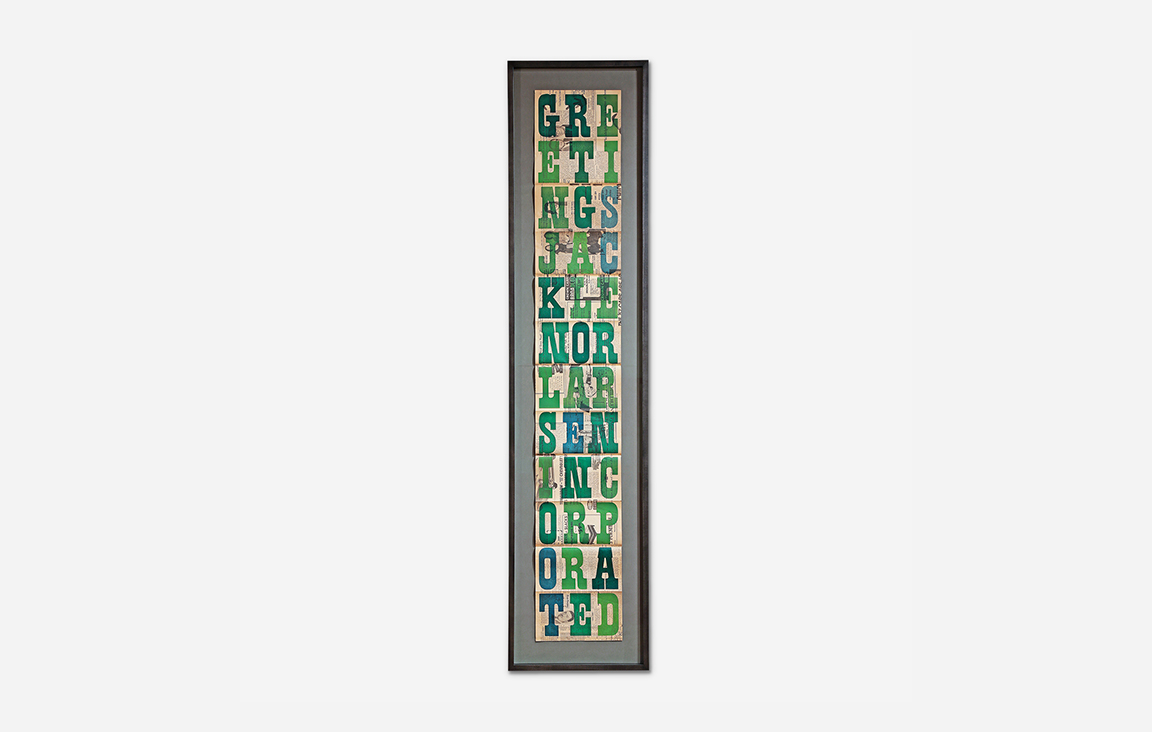No products in the cart.
Design Miami + Moderne Gallery | Christmas Card Collage : A one-of-a-kind work-on-paper by iconic American composer John Cage
- March 17, 2021
- -
In 1956, a special project brought together an impressive group of American creatives. Composer John Cage and dancer-choreographer Merce Cunningham were fundraising for a recital in Rockland County, New York. Along with their close friends, enamel artist Paul Hultberg and his artist wife Ethel Hultberg, Cage and Cunningham approached renowned textile designer Jack Lenor Larsen to help fund the performance.
Interior designer Barbara Dorn had introduced Cage to Larsen in 1952, and around the same time Paul Hultberg had been hired to produce textile designs for Larsen. In those years, Cage and the Hultbergs were living in the Gate Hill Cooperative in Stony Point, New York, an experimental artist colony that was populated by a number of Black Mountain College alums, including artist Robert Rauschenberg.
As a way of contributing to the recital, Larsen commissioned Cage to design his company’s 1956 Christmas card.
While sharing breakfast with the Hultbergs in their kitchen one morning—a frequent activity for the friends—Cage proposed the Christmas card design he had in mind: an unfolding card on newsprint that would fit into a lightweight elegant box to be mailed out to Larsen’s clients and friends.
Cage sketched out the letters’ shapes and sizes and determined their placement and composition. The Hultbergs cut everything out according to Cage’s specifications and pasted it together at their kitchen table.
“Cage selected the words, articles, subjects, and images from multiple newspapers—$3.60 worth,” explains Robert Aibel Ph.D. of Moderne Gallery. “Those were likely not random choices, because he could have simply used various parts of one newspaper. There appears to be a method to his madness, even though random choice would make sense considering his interest in chance and indeterminacy.”
The resulting collage is 70 inches long and 12 inches wide. The original was taken to a local commercial printer to be reproduced, folded, and mailed out to Larsen’s list, which included Rauschenberg.
Rauschenberg plays an intriguing background part in this story. He is well known for using collage and lettering in his work and often incorporated newsprint. As Cage and Rauschenberg were neighbors in 1956, it’s possible that Rauschenberg suggested newsprint to Cage as he developed the Christmas card design. But it’s also possible that Rauschenberg’s art was influenced by Cage’s use of newspaper in the card.
Even though Cage and Rauschenberg were good friends at Gate Hill, Ethel Hultberg has no recollection of Rauschenberg’s involvement with the design. The Hultbergs and Cage were the ones who executed it at the kitchen table. So it’s all the more plausible that it was Cage’s use of newsprint that affected Rauschenberg, rather than the other way around.
“As far as I have determined, the first use that Rauschenberg made of newspaper print in his collages was in the late 1950s—more notably in 1962,” Aibel states. He adds, “The 1970 Currents silkscreen series had a much more extensive use of newspaper.”
Aibel recalls an email conversation with Simon Andrews, internationally recognized expert in 20th-century design and material culture, that followed Andrews’s inquiry about the piece after seeing it for the first time at Design Miami/ 2019: “Thank you very much for the good conversations and for those images of the Cage. To my mind, it was amongst the most intriguing and conceptually-pivotal of all the works, of all classifications and periods, to surface at Miami this year.”
Cage gave the Hultbergs the original collage, the only known extant copy. Today it is available through Moderne Gallery.
Read full article HERE
Join Our Mailing List: Get the latest news, exclusive fair previews, and special access to new acquisitions.
We respect your privacy and promise to only send you the best content.
